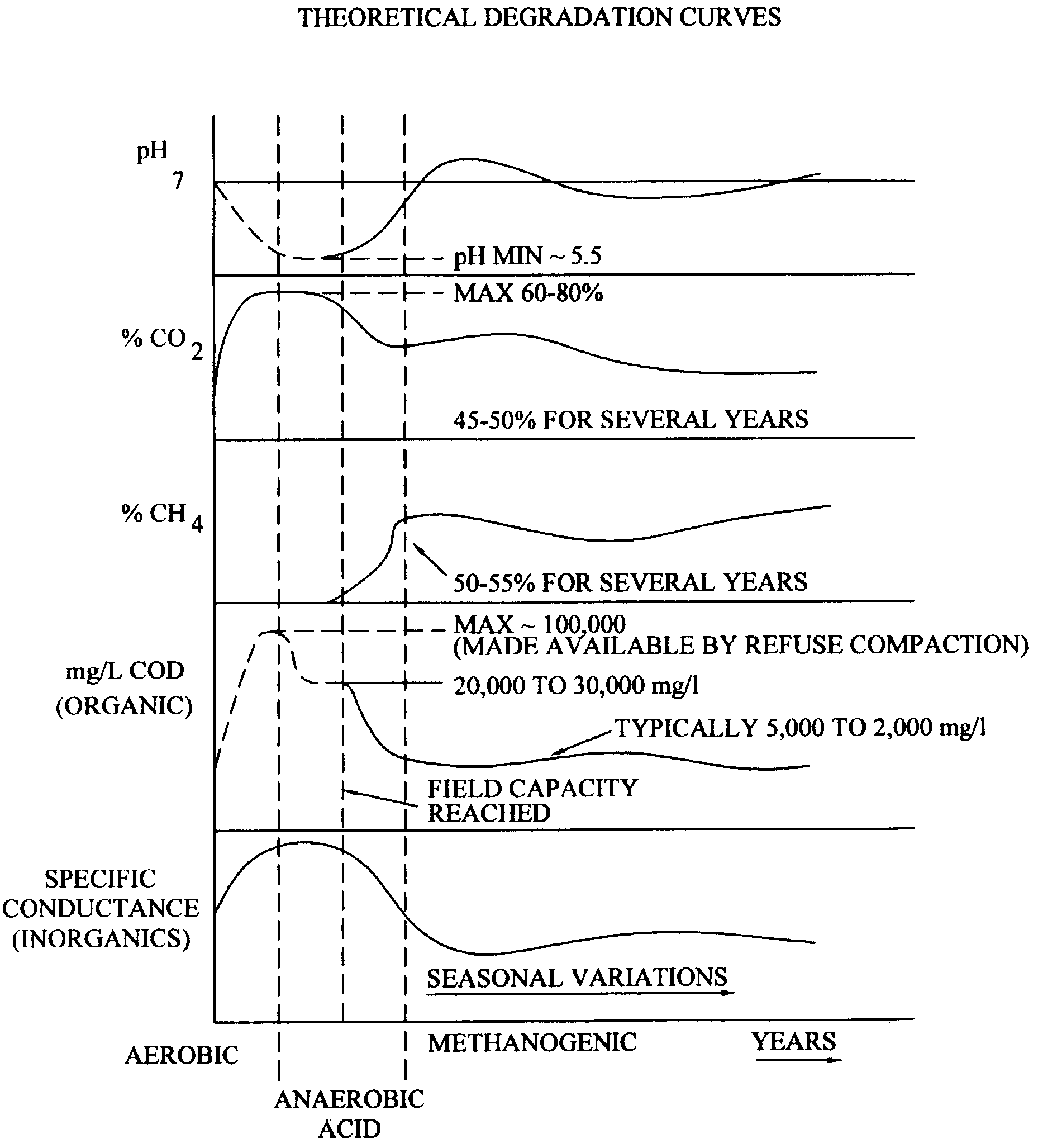Hazardous waste stabilization methods, products and testing procedures
a technology of hazardous waste and stabilization methods, applied in the field of metal-bearing waste stabilization, analysis and landfill disposal, can solve the problems of difficult to find environmentally responsible disposal techniques of waste products, many industrial wastes are not amenable to thermal, chemical, biological destruction, etc., to promote business, protect the environment, and stabilize metal-bearing wastes.
- Summary
- Abstract
- Description
- Claims
- Application Information
AI Technical Summary
Benefits of technology
Problems solved by technology
Method used
Image
Examples
example 1
Study of ORP Environment of Two Industrial Landfills Containing Treated Residues From Industrial Waste
Materials and Methods
[0064]1. Two landfills constructed with synthetic liners had contained waste materials. During containment, the waste was covered nearly immediately upon filling with native soil. Once a cell, a section of an entire landfill, reached capacity, which is typically after many tens of feet of waste material has been placed in a cell, the cell was closed. The waste of the cells were considered inorganic, however, small quantities of organic components were present, and these components served as energy sources for bacterial growth, thus creating a reducing environment. The origin of the organic material was attributable to detergents, surfactants, wetting compounds, oily solids from used oil processing operations, and non-hazardous waste waters with an organic component. In addition, straw, plastic, personal protective equipment, and other materials with carbon conte...
example 2
Stability of Treated EAF Dust Tested by Standard TCLP
Materials and Methods
[0072]1. Treatment of Waste
[0073]A. The pH of 100 grams of EAF Dust was adjusted to achieve an extract pH of 11.5 using lime.
[0074]B. Sufficient sodium hydrosulfide (NaSH) was then added to achieve a 1% (wt. / wt.) mixture.
[0075]2. Stability Determination of Waste
[0076]A. The treated waste was then extracted under neutral and alkaline conditions according to EPA method 1311 of SW 846.
[0077]B. The treated waste extracted in step 2A above was extracted three additional times, once each day from the first day of extraction.
[0078]C. The specific metal content, oxidation reduction potential, sulfide content and pH of each leachate extracted was then determined. This data is represented in Table 2.
[0079]
TABLE 2Leachate characteristics of stabilized waste under standard extractconditionsFirstSecondThirdFourthExtractionExtractionExtractionExtractionNeutral Leachate (pH 6)pH11.311.711.511.3ORP (mV)−388−30−30−35Sulfide (m...
example 3
Stability of Treated EAF Dust Tested by Modified TCLP in Accordance with Present Invention
Materials and Methods
[0081]1. Treatment of Waste
[0082]A. The pH of 100 grams of EAF Dust was adjusted to achieve an extract pH of 11.5 using lime.
[0083]B. Sufficient NaSH was then added to achieve a 1% (wt. / wt.) mixture.
[0084]2. Stability Determination of Waste
[0085]A. The treated waste was then extracted under neutral and alkaline conditions according to EPA method 1311 of SW 846 modified according to this invention. Particularly, exposure of the waste material to the extracting fluid was preferred in a zero headspace extractor (ZHE). Further modifying 1311, separation of the extraction fluid from the waste material to form an extract was conducted under a nitrogen atmosphere.
[0086]B. The same treated waste extracted in step 2A above was extracted three additional times according to the described method, once each day from the first day of extraction.
[0087]C. The specific metal content, oxidat...
PUM
| Property | Measurement | Unit |
|---|---|---|
| oxidation reduction potential | aaaaa | aaaaa |
| oxidation reduction potential | aaaaa | aaaaa |
| time | aaaaa | aaaaa |
Abstract
Description
Claims
Application Information
 Login to View More
Login to View More - R&D
- Intellectual Property
- Life Sciences
- Materials
- Tech Scout
- Unparalleled Data Quality
- Higher Quality Content
- 60% Fewer Hallucinations
Browse by: Latest US Patents, China's latest patents, Technical Efficacy Thesaurus, Application Domain, Technology Topic, Popular Technical Reports.
© 2025 PatSnap. All rights reserved.Legal|Privacy policy|Modern Slavery Act Transparency Statement|Sitemap|About US| Contact US: help@patsnap.com



